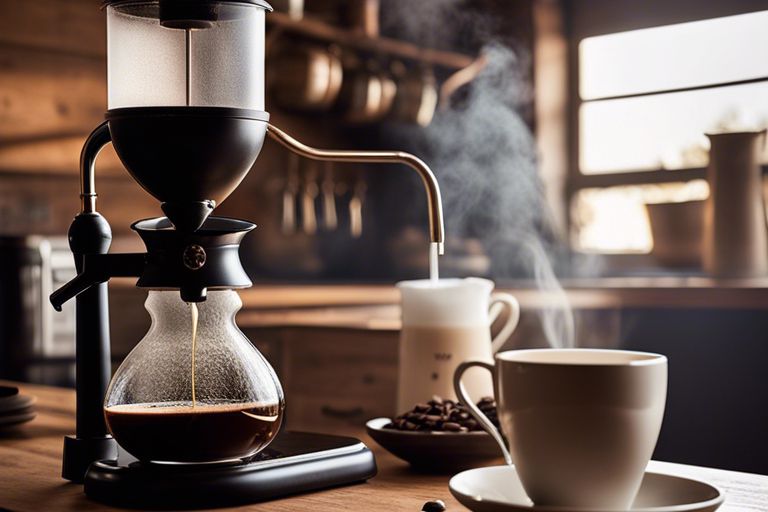Blog
Acidity in Coffee: Your Guide to Flavours & Brewing Tips
If you’ve ever sipped a cup of coffee and winced at the sharp, tangy taste, you’re already familiar with acidity in coffee. This characteristic is as vital to your morning brew as the beans themselves, often contributing to its vibrant flavour profile.
Understanding what influences acidity can enhance your appreciation for every cup. Whether it’s the bean origin or the brewing method, each factor plays a pivotal role in shaping that zesty kick. Let’s delve into how these elements affect your daily java and ways to achieve the perfect balance that suits your palate.
Acidity may be an elusive concept, but fear not; this post will guide you through its complexities. By grasping these nuances, you’ll be equipped to select and brew coffees that align with your taste preferences seamlessly.
Understanding Coffee Acidity
Defining Acidity
Acidity is a key taste element in coffee. It’s not about the sourness, but rather the vibrant quality it brings to your cup. Think of acidity as what gives freshness to fruit. Without it, coffee can seem flat or dull.
When you sip a brew, acidity should be pleasant and add depth to the drink’s flavour. It differs from bitterness, which comes from over-extraction or burnt beans. Bitterness masks other flavours; acidity highlights them.
Acids are crucial for balance in coffee flavour. They make each sip more exciting and bring out natural sweetness and fruity notes.
Acidity vs Sourness
It’s easy to confuse acidity with sourness, but they’re not the same. Not all acids taste sour; some even add sweetness or saltiness to your drink.
In coffee, acidity adds complexity and makes other tastes stand out better—like berries or chocolate notes that might otherwise go unnoticed.
Think of how lemon enhances fish without making it sour—that’s similar to what acid does for your brew!
pH Levels in Coffee
Brewed coffee has a typical pH range between 4.85 and 5.10—a bit acidic but less so than orange juice! The lower the pH number (closer to zero), the more acidic something is.
Your perception of acidity doesn’t always match actual pH levels though—it’s about how acids interact on your palate.
A lower pH can give coffee a sharper edge while higher values create smoother sensations in your mouthfeel.
Types of Acids in Coffee
Citric Acid
Arabica beans are known for their citric acid content. This acid gives coffee fruity notes that many of you enjoy. The levels of citric acid can vary depending on where the coffee is grown.
For example, beans from Kenya often have a high citric acid level. This results in a bright and vibrant taste. In contrast, Colombian coffees might have less citric acid, offering a more balanced flavour profile.
Malic Acid
Malic acid is another component that influences your cup’s flavour. It’s linked to apple-like tastes which add crispness to coffee. Different bean varieties will affect the amount of malic acid present.
Some beans may produce a sharper taste due to higher malic acidity, while others are milder. Think about biting into a fresh green apple; that’s the effect malic acid has on some coffees!
Chlorogenic Acid
Chlorogenic acids play a big part in coffee’s unique character too. They contribute to astringency, giving your brew its distinctive bite. Roasting changes chlorogenic acids quite dramatically.
During roasting, these acids break down, reducing bitterness but also altering health benefits they may carry. Studies suggest chlorogenic acids could be good for you by helping with things like blood sugar control.
Origins of Coffee Acidity
Bean Origin
The geographic origin of coffee beans greatly influences their natural acidity. For example, beans from East Africa often have a bright, wine-like acidity. This is because the soil and climate in these regions contribute to the development of certain acids within the coffee cherry.
Beans from Latin America, on the other hand, might offer a sharper, citrus-like tang. The specific types of acids present are directly tied to where they’re grown. You’ll find that Kenyan coffees often contain high levels of citric acid while Ethiopian varieties may boast more malic acid.
Growing Altitude
Altitude plays a crucial role in bean development and its resulting acidity. Beans grown at higher altitudes mature slower than those at lower heights due to cooler temperatures. This slow maturation allows for more complex sugars to develop which later translate into heightened acidity in your cup.
When comparing low-altitude beans with those grown higher up, you’ll notice that high-altitude ones often have a crisper and more vibrant taste profile. These qualities make them highly sought after in specialty coffee grading systems where unique flavour notes are prized.
Processing Methods
Different processing methods can also affect a bean’s level of acidity. Washed or wet-processed coffees typically exhibit cleaner and more pronounced acidic flavours as this method removes the fruit flesh from the bean quickly with little fermentation time.
Natural or dry processing involves drying whole cherries which can lead to wilder acidic profiles influenced by longer fermentation periods during drying. Honey processed coffees fall somewhere between washed and natural methods regarding their influence on acidity; some mucilage remains on the bean influencing both sweetness and tartness levels.
Processing doesn’t just alter taste but also affects how long that zesty kick lasts on your palate due to changes it causes in acidic compounds within the beans themselves.
Roasting and Acidity Levels
Roast Profiles
Roasting coffee is a delicate art. It transforms green beans into the rich, aromatic ones you enjoy every day. The level of roast can significantly affect a coffee’s acidity. Light roasts usually keep more of their natural acidity than darker ones.
When beans are roasted for less time or at lower temperatures, they retain higher levels of acid. This means light roasts often have a brighter, tangier taste which some people love. On the other hand, as the roast gets darker, acids break down and create a smoother feel.
To highlight certain acidic notes in your cup, choosing the right roast profile is crucial. If you fancy sharp citrus flavours, stick with lighter roasts. For subtler acidity with hints of fruit or wine-like tastes, medium roasts are ideal.
Bean Selection
Choosing coffee beans isn’t just about picking any bag off the shelf; it’s about finding what suits your palate best! Different beans come with different acid profiles that can greatly influence your brew’s taste.
Professional tasters play an important role here – they help identify which beans will meet specific flavour goals. They look for quality and consistency in each batch to ensure you get exactly what you’re after – whether it’s bright lemony notes or deep chocolate undertones.
If you’re keen on unique acidic characteristics in your coffee, consider single-origin beans over blends:
- Single-origin: Offers distinct taste linked to its growing region.
- Blends: Combine several origins for balanced flavour profiles.
Selecting based on desired acid levels helps tailor each sip to perfection!
Tasting Coffee Acidity
When you taste coffee, acidity is one of the key flavours that dances on your tongue. It’s what gives some coffees a bright, tart, or even crisp sensation. During cupping sessions, which are like tasting events for coffee, you can learn to spot these sensory cues. Imagine sipping a lemonade; it has a sharp tangy taste – that’s similar to what acidity in coffee feels like.
To train your palate, start by trying different coffees and noting their acidic qualities. Some might remind you of citrus fruits while others feel more like berries. Each type of acid leaves its own mark on your taste buds. Remember, an acidic cup doesn’t mean sour; it should be pleasantly refreshing.
Flavour Impact
Acids play with other flavour compounds in ways that can truly make your cup of coffee stand out. They add balance so no single taste overpowers the rest. Think about eating a piece of cake with some lemon zest on top – without the zest, the sweetness would be too much, but with it? The flavour sings!
Your drinking experience also gets livelier thanks to acids in coffee grounds. They contribute to that vibrant feeling as if each sip wakes up your senses anew. And when the last drop from your cup dries up? That lingering aftertaste is often courtesy of those same acids working their magic long after you’ve finished drinking.
Managing Acidity in Brewing
Brewing Techniques
Brewing coffee is an art, and the technique you choose affects its acidity. Pour-over methods often highlight a coffee’s bright notes, while espresso can concentrate them. To control acidity levels, consider the water temperature. Cooler water slows acid extraction; thus, it yields a milder cup. Conversely, hotter water may enhance acidic flavours.
Experiment with brew times to find the right balance for your palate. A shorter brew time can lead to less extracted acids, giving a smoother taste. Longer brewing might increase acidity but beware of over-extraction which could introduce bitterness.
Grind Size Adjustment
The size of your coffee grounds plays a critical role in flavour development too. Finer grinds mean more surface area for water to interact with and can result in higher acid extraction. This is useful when aiming for a vibrant cup using methods like espresso or Aeropress.
However, pairing grind size with brewing method is key to achieving your desired level of acidity without compromising overall flavour quality. For example:
- Use coarser grinds for slower methods like French press.
- Opt for finer grinds if you prefer quick methods such as espresso.
Beware that inconsistent grind sizes can cause uneven extraction and unpredictable acidity levels.
Health and Coffee Acidity
Acidity Concerns
Understanding the acidity in coffee can help you enjoy your cup without worry. Some people think acidic coffees cause stomach discomfort, but this isn’t always true. It’s important to know that not all acid is bad for you. In fact, some acidity can be good.
Coffee’s acidity doesn’t necessarily mean it will upset your stomach. Each person reacts differently to coffee because of their own digestive sensitivity. So, if a friend says a certain coffee upsets their stomach, it might not do the same to yours.
A common myth is that dark roasts are less acidic and therefore better for sensitive stomachs. This isn’t quite right — roast level affects taste more than actual acid content. Dark roasts may taste less sharp but don’t assume they’re easier on your tummy.
Low Acid Coffee Varieties
Bean Selection
Selecting the right coffee beans is crucial for enjoying a cup with less acidity. Typically, dark roast coffee beans are known for having lower acid levels compared to light roasts. This is because the longer roasting process reduces the bean’s natural acidity. When you choose your beans, consider opting for dark roasts if you prefer a smoother taste.
The origin of the coffee can influence its acidity. Some origin coffees, which come from specific parts of the world, naturally have lower acid contents. For example, beans from Brazil and Sumatra are often recommended for those seeking milder flavours.
Brewing for Low Acidity
Brewing methods also play a significant role in reducing perceived acidity in your cup of coffee. Techniques like cold brewing can significantly cut down on acidic notes since cold water extracts fewer acids than hot water does during brewing.
It’s important to understand that water mineral content affects your brew’s final taste and level of acidity. Water that’s too hard may not extract all of the flavours properly and could lead to higher perceived acid levels; soft water might make your coffee flat-tasting but with less bite.
For those preferring smoother cups with low acid profiles:
- Try using a French press or an espresso machine.
- Experiment with different grind sizes to find what works best for lowering acidity without compromising flavour.
- Consider investing in a good quality water filter to control mineral content before brewing.
Terroir and Acidity Influence
Soil Conditions
The soil where coffee grows is like a secret recipe. It has a big say in how your coffee tastes. Soil pH and what’s in the soil can make beans more or less acidic. For example, if the ground is full of certain minerals, your morning cup might have a zingy taste.
Organic matter also matters. It helps create different acid flavours inside the bean. Think of it as adding spices to food – it makes things interesting! Different soils like volcanic, clay, or loamy ones can change how sharp or tangy your drink feels on your tongue.
Climate Effects
Now let’s talk about the weather and how it changes your brew. As our planet gets warmer, places that grow coffee could see their beans’ acidity levels change too. This means that even traditional regions might surprise you with new tastes!
Seasons play their part as well. The weather during growing time affects each year’s crop differently – sometimes making it more sour than sweet or vice versa.
In future years, because of global warming, we may need to rethink what ‘typical’ flavours come from which regions.
Closing Thoughts
Delving into the intricacies of coffee acidity, you’ve explored its origins, the impact of roasting, and how terroir shapes flavour. Understanding the types of acids and their influence on health has equipped you with knowledge to refine your brewing techniques and select low acid varieties if preferred. Coffee’s acidity is not merely a taste dimension but an attribute shaped by myriad factors from bean to cup.
Take this insight into your daily ritual. Experiment with different beans, roasting levels, and brewing methods to discover your ideal balance of acidity. Share your experiences and continue the conversation about coffee’s vibrant complexity. Your palate’s journey is a personal adventure in taste and understanding.
Frequently Asked Questions
What causes acidity in coffee?
Coffee acidity is primarily due to organic acids contained within the beans, including citric, malic, and chlorogenic acids. These are influenced by factors such as bean origin and variety.
How does roasting affect coffee’s acidity?
Roasting impacts acidity levels in coffee; lighter roasts typically retain higher acidity compared to darker roasts which tend to have less perceived acid due to the breakdown of acid compounds during longer roasting.
Can you taste the difference in acidity between coffees?
Yes, one can discern varying levels of tartness or brightness when tasting different coffees. This sensory experience is attributed to the type and concentration of acids present in the coffee.
Are there ways to brew coffee that reduce its acidity?
Managing brewing variables like grind size, water temperature, and extraction time can mitigate perceived acidity. Cold brewing also typically results in a smoother cup with lower apparent acidic bite.
Is drinking acidic coffee harmful for health?
For most people, consuming acidic beverages like coffee is not harmful. However, individuals with certain health conditions may need to limit their intake of acidic foods and drinks.
Which types of coffee are low in acid?
Low-acid varieties often come from regions with lower elevation growing conditions or are treated during processing to reduce their natural acid content. Beans marketed specifically as low-acid are available for those seeking milder options.



